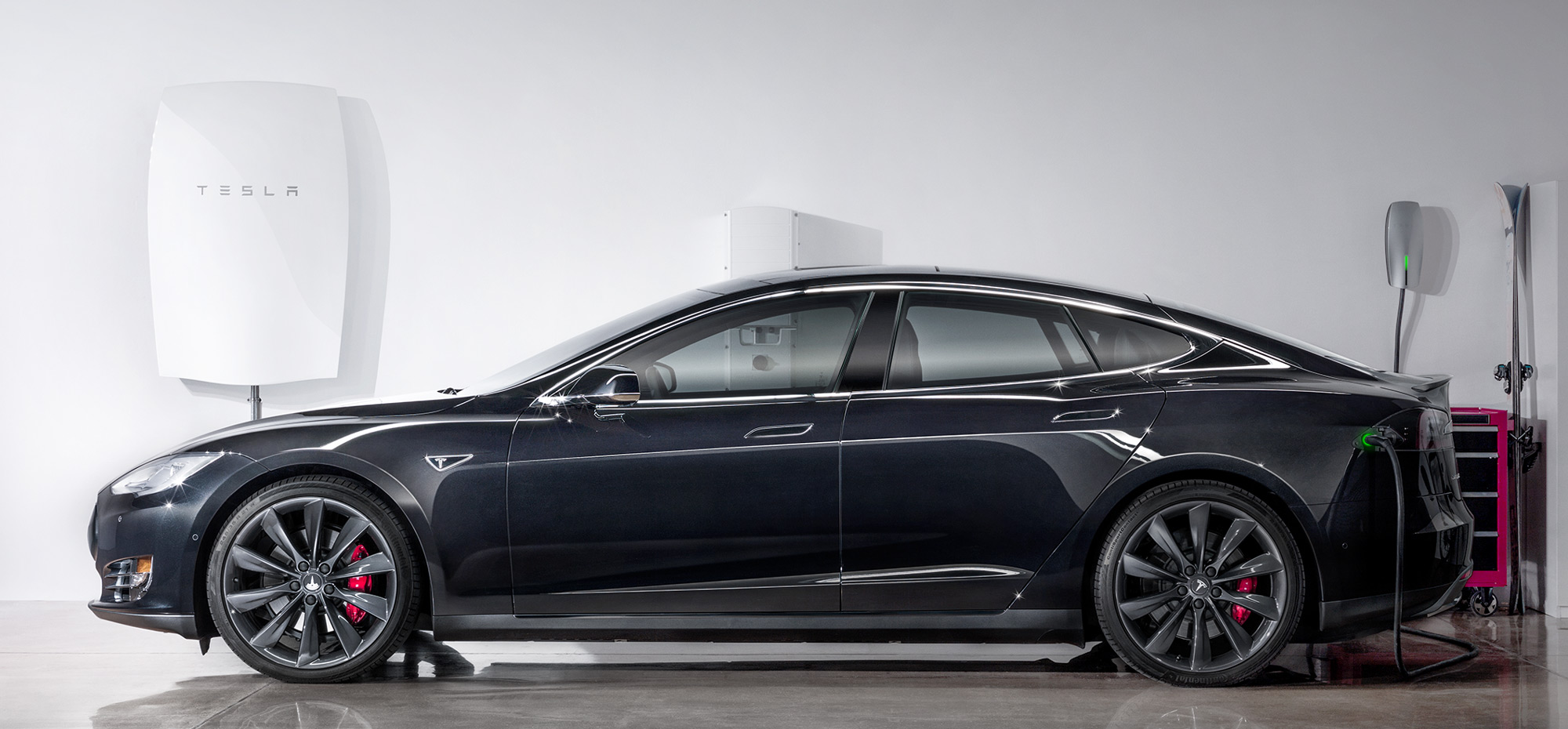The announcement by electric car maker Tesla of their new Powerwall battery has garnered a tremendous amount of media attention and interest from our new and existing client base. Rightfully so, Elon Musk is a game changer, an extraordinary entrepreneur with tremendous vision. However, can Tesla live up to the hype and how would the Tesla battery’s benefits apply in the Western Canadian market which is much different from California?
Tesla Powerwall battery with Tesla Model S electric vehicle – Image source: Tesla
The PowerWall (and battery storage in general) holds 4 key potential advantages:
- Back-up power for grid outages
- Smart metering and peak demand limiting advantages
- Self consumption of generated solar energy
- And the holy grail – Off-grid
Back up Power
Most systems that SkyFire designs and install are directly grid connected without any storage. Systems without batteries are much simpler, more efficient and economical. Back-up power is not of significant concern for most customers we work with – our grid is extremely reliable (generally speaking). Most outages last only hours and happen every few years. Of course, Calgary in particular has seen major exceptions to this with the 2013 flood, the winter storm of September 2014 and the downtown electrical fire. One homeowner in Bragg Creek, AB was able to keep his house dry during the 2013 floods because of the backup power system we put in place – a one flood payback in that case.
Bragg Creek, AB home – grid tied solar electric system with battery backup – click on image for more details
Backup power for most customers, however, is a nice to have option but typically out of budget. Does the Tesla battery change this and hold advantages over current technologies? There is still some mystery regarding this battery but let’s compare as best we can:
| TESLA – Powerwall (10 kWh) | Surrette – AGM (4x S6-460AGM) | |
|---|---|---|
| Capacity | 10 kWh | ~10 kWh @ 20 hour discharge rate |
| Warranty | 10 years | 5 year pro-rated |
| Efficiency | 92% round trip | ~80-85% |
| Voltage | 350-450 VDC | 6 V per battery; 4 batteries in series = 24VDC |
| Notes | Unclear as to what inverters this may integrate with yet to convert higher voltage DC to AC household power | Can be wired in 12, 24 and 48V banks to work with existing grid interactive inverters |
| Weight | 220 lbs | 493 lbs |
| Maintenance | Unknown | Sealed batteries – ‘maintenance free’ |
| Cost | $3500 USD? | ~$3300 CDN including batteries, wiring between batteries and battery storage box |
See Rolls/Surrette S6-460 spec sheet here: http://rollsbattery.com/public/specsheets/spec_74.pdf
In my opinion, the Tesla battery is a better deal – the small additional cost for the battery will be negated by savings on the installation and future replacement costs. The higher efficiency and much better warranty is very appealing. It sounds like grid tied inverter manufacturer Fronius is working with Tesla on a battery based inverter to work with the higher voltage but details are sparse at the moment.
Note that as a complete system, either option above would likely cost ~$10,000+ to add to a home when including the integrating components (battery based grid interactive inverters are very expensive, other electrical components, back up loads panel, labour, permits, etc).
Is this a game changer for the back up power market in Western Canada? – Maybe, but the backup power market is currently very small and I do not anticipate more people leaping into this market because of the new Tesla option. For those that are putting backup batteries in anyways – the Tesla battery looks like it could be a great option over existing battery systems.
Smart-metering benefits
One of the key selling features of the Powerwall is the ability to purchase or store energy when grid prices are low so as to sell the energy back when grid prices are higher. Medium and large commercial customers may have interval (hourly) meters in Alberta and so could capture this benefit. Smart metering however does not currently exist for residential customers in Alberta although it will likely be here eventually. If we did have smart meters, what would this benefit look like?
For simplicity sake, lets take the AESO (Alberta Electric System Operator) average 2014 on-peak (7am – 11pm) price of 6.148 cents/kWh and the average off-peak price of 2.528 cents/kWh. Tesla Powerwall’s daily cycle unit has a capacity of 7kWh and a cost of $3000. Assuming daily cycles of 7kWh at 92% efficiency – this is a financial benefit of $0.23/day or $85/yr. This is a bit simplistic as Alberta pool pricing in Alberta does jump around and can be as high as $1/kWh at times. However, even assuming the benefit was 3+ times the calculated amount above, is a $300 annual benefit on a system that will cost $8000+ enough to encourage people to take the leap? I don’t see this as a game changer yet.
Greater opportunity lies in commercial applications where electricity charges are greater weighted towards demand (peak power (kW or kVA) consumption) charges rather than energy (kWh) consumption. Batteries have the potential to limit the peak power demand of a building or industrial site and thus significantly reduce delivery costs from the wires service provider. We will need to see what inverter technolgies (for higher voltage DC) and price point looks like before we can analyze the economics of this in greater detail.
Time of day pricing and demand charges will vary with location and wires service provider – where demand and price peaks are more significant or where penalties for peak power consumption are higher, the economics here could change. Utilities in some jurisdictions are now providing incentives for storage systems which of course change the economics again.
Self consumption benefits
Solar production already aligns very nicely with peak prices and peak demand in Alberta so the benefits of adding storage are limited in this regard as well. If the energy is consumed on site it is however worth more than if it is exported to the grid for residential applications. The variable portions of the delivery (distribution, transmission, local access fee charges, etc) are typically from 2-11 cents/kWh. (~4 cents/kWh in both Edmonton and Calgary). Based on these variable delivery charges in Edmonton and Calgary, the potential benefit per battery would be $0.28/day or $102.2 per year of additional savings from the solar. It is unclear what the life on the battery might be but it is likely that even in the best case scenario, payback would be reached at the same time that a battery replacement is required.
Off-grid
Does the Tesla Powerwall battery now allow average homeowners to go off the grid? This is many homeowners dream – to cut ties with the utility and forego those tiresome monthly bills. The biggest challenge with off grid in Canada is our lack of sunlight in the winter months. We have a world class solar resource in Alberta (see https://skyfireenergy.com/canada-versus-the-world/) but the solar energy available is highly concentrated towards the summer months. December and January are dark and snowy which means the power generation for an off-grid home needs to be supplemented by other sources. Small wind is unreliable, expensive and needs to be sited 50′ above anything within 300′ to be effective which is not possible in an urban setting. The only other option for power generation is really a generator. Good quality generators are expensive and add more maintenance and complexity to a system. Additionally, we consume more electricity in the winter months due to greater lighting and heating system loads.
Solar modules in an off grid system should to be orientated very steeply (60 plus degrees from horizontal) to capture the lower winter sun. This limits the amount of solar a homeowner can put on the roof. It would be an extremely rare case where a home in Alberta had enough room for the solar required and low enough winter electrical loads to be able to go off the grid in december and january without significant generator input. Furthermore, off-grid solar arrays are better suited on the ground where they can be cleared of snow more easily which again presents challenges for the average homeowner. Even in a best case off-grid scenario, we generally design the battery back-up for only 3-7 days of no sun due to the high cost of storage. The high cost for battery storage usually means our off-grid customers limit the battery bank size and install a back-up generator for those longer periods of no or limited sun.
The economic case does not work in comparison to a grid-tied solar electric system without batteries – the cost of the major system overbuild required for living off-grid in the winter will never be offset by the electrical bill savings. Off grid economics work in remote areas where there is no grid power, electrical loads are limited and bringing in power lines is expensive. Where the grid infrastructure is already in place, off-grid in Alberta really makes no sense with any battery available on the market. The Tesla battery does not change this. Converting a grid tied home to off grid is much more viable though in Southern locations (ie California) where there is more winter sunlight and the seasonal differences are less extreme.
In Summary
Elon Musk and Tesla have taken an ugly, clunky old technology and turned it into a beautiful consumer product with mass appeal. In the Alberta context though, the cost/benefit of battery based systems remains limited. Further cost decreases and greater time of day pricing disparity is required to make the economics work. As this and other battery-based product gain traction in other markets (California, Germany, etc) where there is greater incentive and economic benefit to install these systems, we should see the benefits improve here as well.



